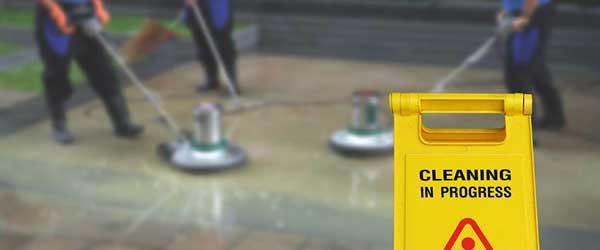Injuries are going to happen, but they can cost you less than you think.
One inevitable fact of running a residential cleaning business is that your employees are going to get hurt. This is a simple fact of the industry and the nature of the work.
The best way to help the injured worker accomplish this is to get them the proper medical care and to get them involved in a return to work program in a timely fashion. This can only be accomplished when the business creates a culture that promotes transparency. A culture that rewards employees for being safe and reporting all incidents in a timely fashion. This can be accomplished best when the leadership, employees and the insurance carrier are all involved in this process.
Prevention Begins with Reporting and Documenting
Regardless of whether these injuries are large or small, they need to be reported and documented. Reporting and documenting all injuries is simply the right thing to do, both for your employees and for your business. This reporting can help your employees by speeding up the process of getting them the proper medical attention and helping your business by quickly getting them involved in a return-to-work program.
Having a program for reporting and documenting injuries is best for preventing the injuries in the first place. Problems that repeatedly continue to occur need to be addressed promptly. Reporting and documenting injuries can benefit your business by helping you determine if there are patterns in the type of injuries occurring and how to address them. It can also help you determine the severity of the injuries that are occurring and can help you fix these problems before they become much worse.
Reporting and documenting needs to be faithfully completed in order to know what injuries to address, what is causing those injuries and how those injuries are affecting your business. This is done to prevent your employees from being injured in the first place and to prevent injuries and claims from spiraling out of control. This is simply the right thing to do for the welfare of your employees and for the health of your business.
Safety and Safe Driving Training
First and foremost, reporting and documenting injuries needs to be a part of your company culture. It should start with the first training all employees get during the onboarding process. This can go hand in hand with your business’s safety program and your business’s safe driving program.
Since most residential cleaning businesses have employees driving to one or more residences throughout the day, both of these programs should be in place, along with a return-to-work program. It is best to implement these all in one extensive program. These training programs should begin at hiring and repeated at least on a yearly basis. This may seem time-consuming, but the benefits in fewer and less dramatic injuries and lower premiums on workers’ comp insurance will benefit your business immensely.
Communicate with your Workers’ Comp Insurer
Typically injured employees are more likely to return to work if they quickly get into the workers’ compensation system. Working with your insurance carrier is crucial to making sure this process goes smoothly. This is because your carrier will know which medical facilities are most efficient at operating the workers’ compensation process and which medical facilities have the easiest access to specialists.
Believe it or not, insurance carriers care about your injured workers. Carriers have departments that deal with nothing but getting injured workers the proper care at the best facilities in your area. Statistics show that the sooner the carrier is notified about an injury, the more likely that injured worker is to get proper medical care and is more likely to return to work.
Safety Training and Injury Reporting as Part of Employee Engagement
When done well and consistently, your injury reporting plan can be an asset to your business. It shows your employees that you care about your employees beyond simply what they can do for you. After all, they are your most precious asset. Letting them know you care about them, and doing it in a genuine way, can forge loyalty that is necessary to the health of any small business.
Furthermore, it is crucial to create an atmosphere within your business of complete transparency. Issues like reporting injuries can create a fear of retaliation or being passed over for a promotion. As part of your training program, you should be crystal clear that reporting these injuries will never reflect negatively upon any employee. Then it is crucially important to follow through on that promise. In fact, the culture should create a feeling just the opposite.
Return-to-Work Program
In the residential cleaning industry, back issues are common place. Back issues are also one of the biggest concerns for your insurance carrier. Injuries involving the back tend to be the most frequent and they also tend to have the highest rate of re-injury. These are the types of injuries that tend to drag on, get costlier and eventually get to the point where someone never returns to work. This is why preventing these issues in the first place is always the best action to take. Implementing a return-to-work program can be crucial to getting the person to eventually return to full-time employment.
As part of your return-to-work program, you should have simple office/clerical duties ready for an injured worker to do in the event of an injury. If an injured worker can be involved in the business before their injury has healed, the likelihood of them returning to work permanently increases greatly. It typically takes two weeks for something to become a habit. If someone is out of work for two weeks, they have already developed a new routine separate from their routine when they worked. The more comfortable they get in this new routine, the less likely they are to return to work.
The absence of a clear and easy-to-implement return-to-work program creates a welcome opportunity for fraudulent workers’ compensation claims, causing you to be short of staff and money; and in many cases, increases in claims may cause you to be dropped by your carrier. If this is your first claim this might not be such a big deal, but if you have numerous claims than you run the risk of not being able to find coverage with any carrier on the open market.
When this happens your business is forced to purchase workers’ compensation insurance from the state fund, also known as the pool. Each state has their own method for providing this provider and the regulations surrounding this process. In most states once you are forced to purchase coverage in this pool, you must continue purchasing coverage in this pool for three years. This is required with the intention of correcting whatever action caused you to lose coverage in the first place.
That’s why voluntarily complying with reporting and documenting protocols now can help you prevent both injuries and the financial losses and insurance headaches of injuries. If repeated injuries are a problem with your business, then a well-documented injury reporting program can alert you of potential problems before they result in you being forced into the pool for purchasing workers’ compensation insurance.
The most beneficial aspect of an injury reporting program is to determine what injuries are occurring most frequently, how severe they are and how you can prevent them in the future. Including your insurance carrier in this process is crucial. They are your partner and not your enemy. It is in the best interest of your business, the carrier and the injured worker for them to get back to work as quickly as possible.






